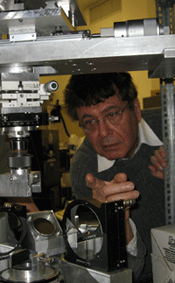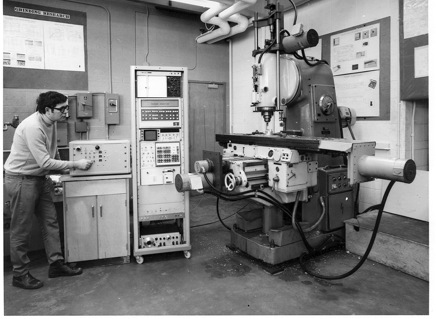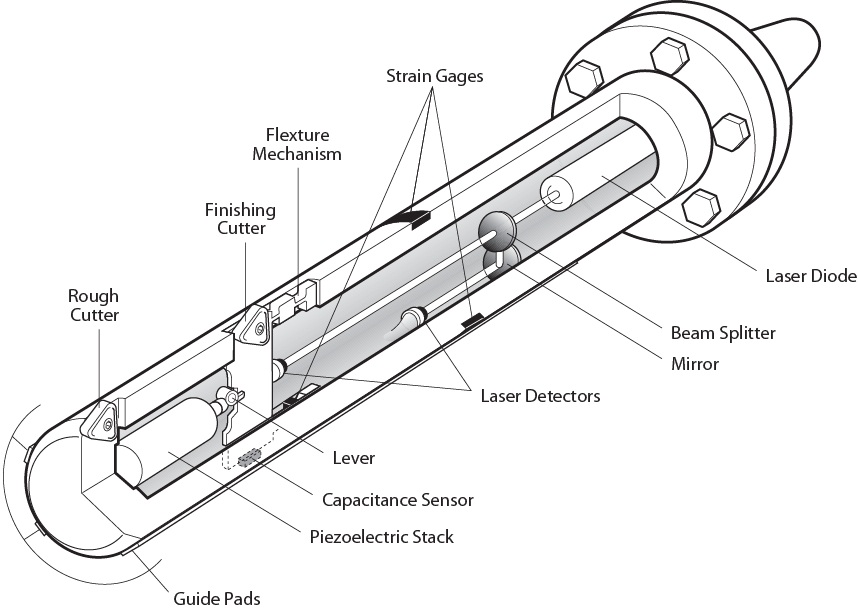Since the late 1960’s Dr. Koren has developed innovative control methods for machine tools aimed at enhancing their precision and increasing their productivity. In a series of 20 papers that Koren published between 1969 and 1982 [see Papers by Topic – CNC] he laid the intellectual foundations for precise control of CNC (computer numerically controlled) machines. CNC manufacturing machines are the backbone of producing high-precision parts such as automobile engines and transmissions, turbine blades for jet engines, and various aluminum parts in the aerospace industry. In 1976, Koren published the world’s first scientific paper on the algorithmic design of interpolators for CNC machines [IEEE Trans. on Computers, Vol. 25 (1), 1976]. These interpolators coordinate the motions of machine axes so that non-linear shapes can be cut on machines, thereby facilitating the production of high-precision complex parts.

In 1973 Dr. Koren invented the worlds first computerized real-time adaptive controller for a milling machine, long before computers were commonly used in industrial applications (see photo below). Koren designed the controller and wrote the software of all algorithms (total memory of the computer was 4K). This adaptive control concept involves letting the machine controller calculate the most productive speed in real-time, during processing, to optimize performance (namely, maximize productivity while maintaining precision). Koren subsequently pioneered the development of adaptive control algorithms for various manufacturing processes to enhance their productivity while maintaining part quality [12 papers in 1974–1985; see Papers by Topic – CNC]. This pioneering technology laid the foundation for an effective means of controlling manufacturing processes – a technology that is currently widely used in industry.

Yoram Koren controls the world’s-first CNC-AC milling machine that he designed (May 1973)
The control computer of both the CNC and the AC was Hewlett-Packard HP-2100. It was a 16-bit computer with a memory of 4096 words (4K), with cycle time of 1 microsecond and 16 I/O slots that were used to send signals to the three control loops and obtained signals from a force sensor mounted on the spindle (Professor J. Tlusty designed the force sensor).
(After Koren left McMaster University in August 1974, Dr. Toshimichi Moriwaki joined McMaster and utilized the machine. This CNC-AC machine was the main research tool for generations of graduate students.)
In 1976 Professor Koren published the world’s-first scientific paper on interpolators for CNC machines (IEEE Trans. Computers, (25), 1, 32-37, 1976). This software interpolator coordinates the cutting trajectory of machine axes that are separately driven.
In 1980, Koren introduced the cross-coupling control (CCC) method, which enhances the precision of CNC systems and thereby produces higher-precision parts that consequently contribute to generating better products [53]. Koren’s paper that introduced the cross-coupling method has now 800 citations. The CCC method has served as the basis for Ph.D. dissertations at various universities. Because the CCC method enhances precision not through investments in hardware, but rather solely by coordinating motion by means of software, machine builders chose to implement Koren’s CCC method, which had a huge impact on the industry and increased the precision of metal parts. In recent years Koren’s CCC method is utilized to synchronize the motion of two robots coordinating a task, and two helicopters coordinating their flight.
In 1983 Professor Koren published his pioneering research in a book Computer Control of Manufacturing Systems[63], which became the standard textbook on this topic at numerous universities worldwide, and is still being studied today, almost 30 years after its publication. Tens of thousands of students have learned about the scientific aspects of flexible automation from this book. Before Koren’s work in the 1970s, numerical control of machine tools was more an empirical craft than a science. Dr. Koren’s research on the synthesis and analysis of CNC systems established a scientific approach to the control of machine tools and manufacturing systems. Many of today’s CNC systems in industry make use of the tools Koren developed through his extensive research in this area.
In 1992 Professor Koren presented his innovative research findings on “Advanced Controllers for Feed Drives” in a keynote speech at the annual General Assembly of CIRP – the International Academy for Production Engineering [74]. He has shown how to design controllers that yield the high precision necessary to cut accurate parts on machines. These precise parts enable the production of high quality products.
Professor Koren’s research established a scientific approach to the synthesis and analysis of CNC systems. Before his work in the 1970s and 1980s, control of machine tools was more of an art than a science. Many CNC systems in use today make use of the algorithms and tools that Koren developed in the course of his research.
In 1995 Dr. Koren developed an innovative boring tool to enhance the precision of automobile engines and thereby reducing engine recalls, The boring machine can control the boring bar in two dimensions: Z and X. But for precise boring also tiny Y motions (up and down) are needed. In a $1 million project Koren designed a real-time compensation system and instructed a team that built a mechatronics compensation system inside the rotating boring bar. The bar position is monitored by laser beams located inside the rotating boring tool (see diagram below) as well as by capacitance sensor and strain-gages. A computer that is also situated in the bar sends feedback signals to piezoelectric actuator to correct in real time positioning errors in the Y direction [90, 93, 94]. This invention integrates laser measurements and sensor signals with real-time control and kinematics to compensate a rotating bar in the Y-direction, and is protected by a U.S. patent [92].

Quotes About Professor Yoram Koren’s Research:
“In the mid 1970’s Professor Koren had already published high-impact papers on flank wear estimation, on the design of drives for CNC, and the world’s-first scientific paper on interpolators for CNC machines. And he had started writing his book Computer Control of Manufacturing Systems – a classic textbook, still widely used today. These would be amazing accomplishments for anyone over an entire career. What is even more amazing is that this was only the beginning.”
- Galip Ulsoy, Distinguished University Professor, U-M, 2012 (inauguration of Koren Conference Room)
“Based on his research and educational accomplishments it was already well known in the 1980’s that more than any one else, Professor Koren was responsible for bringing control theory and control methodologies into the mainstream of manufacturing.”
- Steve Malkin, Distinguished University Professor, U-Mass, 2007 (KorenFest celebration)
“My Ph.D. research at U. Illinois built off Yoram’s Cross-Coupled Control original approach. Following the presentation of my work at a conference, the session chair informed me that Yoram Koren is in the audience. I must admit at that time I felt as though I had a rock star in the audience.”
- Kira Barton, Assistant Professor, University of Michigan, 2012 (inauguration of Koren Conference Room)
“Every few years during the course of his 40-year career, Yoram Koren has initiated a new research field that made a long-lasting impact on industry and the research community. In 1973 Dr. Koren developed the world’s first adaptive control system for machine tools, and in 1976 he introduced a novel method for CNC interpolation. In 1980 he developed an innovative cross-coupling controller that enhances the precision of manufactured products, and in the mid-1990s he introduced and developed the scientific underpinning of reconfigurable manufacturing systems (RMS), and later he pioneered multiple RMS industrial implementations.”
- Moshe Shpitalni (Shefi), Dean, Graduate School, Technion, Israel Institute of Technology, 2011
“I have known Yoram Koren since 1993, when I was a Vice President at Lamb Technicon in Warren, Michigan. Lamb was a technology supplier company to the U.S. automotive industry. In 1994, Yoram made a presentation for the Lamb Board proposing to develop an Agile Line Boring Machine. This project was sponsored by NIST‐ATP at a level of $2 million. Yoram built a consortium with GM, Ford, Chrysler, and Lamb to have the input of the users. The project was executed jointly by the University of Michigan, with Yoram’s leadership, and Lamb. I believe the impressive achievements of the ERC‐RMS were built on the success of this joint project with Lamb.”
— Mark C. Tomlinson, Executive Director, Society of Manufacturing Engineers, 2013
